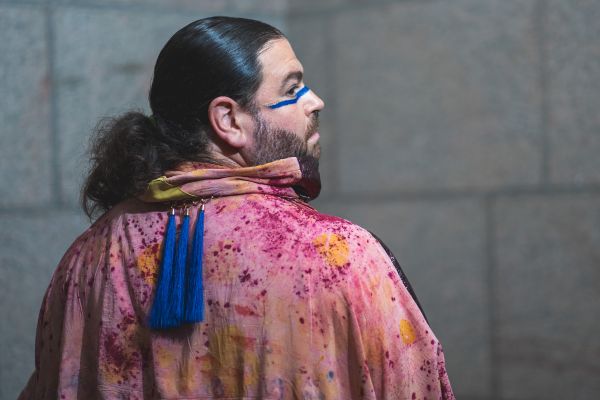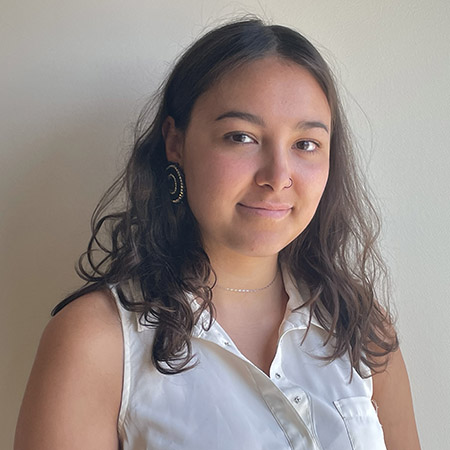
- Details
- By Neely Bardwell
What are you most excited to reveal in the collection?
Baerg: Last year, Ayimach Horizons honored the east, where sunrises and ceremonies begin. So fire was the element that we were honoring, and this year we moved down to the south, which acknowledges red, the summer, and earth metals. I met Melanie Monique Rose in Saskatoon about a year ago, and she works with the most beautiful botanical prints. We thought it would be a great way to honor Earth metal and the color red in the medicine wheel–to tell the stories of the land through botanical prints.
Rose: I’m really excited to share this collaboration on the runway in Santa Fe with Jason. These stories have been collected throughout the summer. For me, it’s been about building relationships with new plant relatives, learning how they can give us color through eco-printing, and how they can be used for medicine. I’ve really enjoyed learning about that, as well as sharing that with my family and Jason. I’m really excited to have those color stories from the land and bring them over here and share that with this audience.
Tell me a little about the process it took to create your collection.
Baerg: We started from that conceptual space of honoring red, the south, and earth metals. Then we wrote a grant. I submitted it, and thankfully we can acknowledge our funders, the Canada Council for the Arts. Then we had Melanie Monique come to Toronto. She visited with me and my family. My cousin Ethan took us on a medicine walk, and then we went to New York City. We then went back to Saskatchewan, where we offered a feast to the Métis community in Regina, and then we got to work. We presented eight looks back in my community, Big River, Saskatchewan. We really centered beautiful Indigenous people on the runway.
In what ways did your Indigeneity influence your designs?
Rose: I found that this whole process really connected me with my ancestors. I just felt there was a connection both forward and behind with me. So, as a Métis woman, it really connected me with the medicine women in my past who used these medicines, these plants for healing and food. Oftentimes, I might go out into the land thinking about a plant I want to find and another plant decides to want to meet me. It was that transmission of knowledge that I felt like I was reaching back to my grandmothers, and they’re saying, ‘Hey, we’ve left this here for you to learn about,’ and I found that very profound and touching. I was able to share this process with my five-year-old daughter, and I just felt that that was a beautiful circle. I feel like that connected me both spiritually and culturally with my mom and who I am
What does Indigenous representation in fashion look like to you?
Rose: There’s been so much cultural appropriation in fashion, and I just absolutely love that I get to be in this space, and I get to be inspired by all the incredible artists who are pushing Indigenous fashion forward, and to me, it’s way forward — it’s storytelling. It’s a way we can tell our stories.
Baerg: I think about the body as a metaphor for everything. I really appreciate the opportunity to celebrate people and honor them, and help them to rise as well. I think Indigenous representation in fashion grants us that opportunity to elevate our people, to celebrate our people, to celebrate our cultures. I’m really grateful for the people that have stepped forward and honored us by participating in the work. It was really, really amazing for me to see my mother in Vogue magazine. She lost her mother; her mother went to a residential school. She lost her mother when she was 19, and so she helped raise her siblings. She had four kids by the time she was 28; she was a single mom, and she has given all of her life. She’s been an incredible role model for so many people. Indigenous representation is so important.
What are you hoping people take away from your collection?
Rose: I’m hoping that there’s a wonder and curiosity of the abundance that the Earth gives us. How many people are familiar with plants and natural dyes? That’s the original way that we dyed; we put color on everything. I want more people to learn about these sustainable practices because the textile industry, especially dyes, is one of the largest polluters in the world. What I want is to really help people to see that abundance because there’s this lie that we keep on being told about scarcity, and I believe that the Earth has so much abundance, and there’s so much to give us. In turn, that gives us this want to protect, hold sacred, build relationships and have relationality to the Earth. I just hope that it inspires people to get outside and put their face in some plants and, you know, squeeze their fingers to some plants or open up a book and learn about how that plant can help them, and how they can help that plant.
Baerg: I’ve always loved fashion. I just think it’s so dynamic. I just hope people feel great energy from the work and they embrace actually being people that step into space, activating fashion in a generous spirit. I hope they take great inspiration and it just charges people to be their biggest, most powerful self.
More Stories Like This
Cherokee Nation Showcases Growing Film Slate with Fall Premieres of Incentive-Supported TitlesChickasaw Artists Represent at Southwestern Association for Indian Arts in Santa Fe
Zuni Partners Share Community-Led Delapna:we Project at ATALM 2025 Conference
Celebrating 50 Years: The Rockwell Museum Looks to the Future with "Native Now"
AMC Announces Return of Dark Winds for Season 4, Premiering February 15
Help us tell the stories that could save Native languages and food traditions
At a critical moment for Indian Country, Native News Online is embarking on our most ambitious reporting project yet: "Cultivating Culture," a three-year investigation into two forces shaping Native community survival—food sovereignty and language revitalization.
The devastating impact of COVID-19 accelerated the loss of Native elders and with them, irreplaceable cultural knowledge. Yet across tribal communities, innovative leaders are fighting back, reclaiming traditional food systems and breathing new life into Native languages. These aren't just cultural preservation efforts—they're powerful pathways to community health, healing, and resilience.
Our dedicated reporting team will spend three years documenting these stories through on-the-ground reporting in 18 tribal communities, producing over 200 in-depth stories, 18 podcast episodes, and multimedia content that amplifies Indigenous voices. We'll show policymakers, funders, and allies how cultural restoration directly impacts physical and mental wellness while celebrating successful models of sovereignty and self-determination.
This isn't corporate media parachuting into Indian Country for a quick story. This is sustained, relationship-based journalism by Native reporters who understand these communities. It's "Warrior Journalism"—fearless reporting that serves the 5.5 million readers who depend on us for news that mainstream media often ignores.
We need your help right now. While we've secured partial funding, we're still $450,000 short of our three-year budget. Our immediate goal is $25,000 this month to keep this critical work moving forward—funding reporter salaries, travel to remote communities, photography, and the deep reporting these stories deserve.
Every dollar directly supports Indigenous journalists telling Indigenous stories. Whether it's $5 or $50, your contribution ensures these vital narratives of resilience, innovation, and hope don't disappear into silence.
 The stakes couldn't be higher. Native languages are being lost at an alarming rate. Food insecurity plagues many tribal communities. But solutions are emerging, and these stories need to be told.
The stakes couldn't be higher. Native languages are being lost at an alarming rate. Food insecurity plagues many tribal communities. But solutions are emerging, and these stories need to be told.
Support independent Native journalism. Fund the stories that matter.
Levi Rickert (Potawatomi), Editor & Publisher

